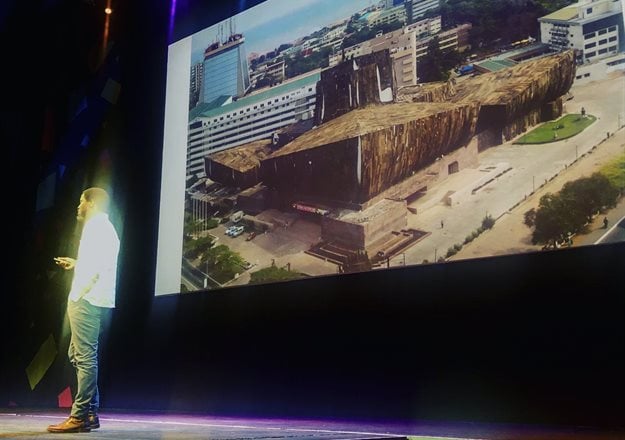#DI2020: African icons at Design Indaba 25

Move over Beyonce and Lady Gaga, if there was ever an icon, Sho Madjozi is it. What a privilege to have her incredible talent and energy blasting off the 25th Design Indaba celebrations. The poster girl for the value of cultural identity preservation with her traditional Tsonga xibelani dress and makwaya dance moves is blazing a trail which could well see her become as iconic as Marilyn Monroe, Josephine Baker or Barbie. Sho!
Nhlanhla Mahlangu
Like the smashed shards of his African pot headdress, Nhlanhla Mahlangu shatters prejudice, preconceptions and stereotypes. His presentation entitled Chant including movement, singing and performance art, somehow manages to bridge cultural divides with unique stories, soundscapes and charm to evoke his upbringing in Pholapark Squatter Camp at the time of violent conflicts between South African factions, pet dogs and gogos - with a captivating humanity and humour that brought him a thunderous standing ovation.
Selassie Atadika
Africa is losing its culinary culture says Chef Selassie Atadika. Heritage conservation is as much a by-product of what she does as culinary preservation. We chatted briefly in the media lounge about the decolonisation of food and her Accra-based restaurant Midunu, which means, “Come, let us eat.” Inspired by former work for Unicef in locations such as the Central African Republic, Cote d’Ivoire, Ethiopia and South Sudan, Atadika fell in love with food from the continent.
Elevating Ghanaian street food to cuisine, sourcing drought-tolerant ancients grains such as millet, sorghum and amaranth leaves directly from farmers, are the raw ingredients for empire rebuilding. Atadika’s passion for stemming the tide of raw exports such as cocoa, has prompted her to create a range of delicious, exotically coloured and flavoured artisanal chocolates, which we got to taste!
Speaking of heritage preservation, ceremonial rites such as the annual Yam fest and changing policy on imported foodstuff means that thanks to people like Atadika, the cultural tide could be turning for Ghana via its culinary and cultural resources.
Behind the jute curtain with Ibrahim Mahama
Anyone who attended the Ibrahim Mahama installation at Cape Town’s Norval Foundation in February 2019 will testify to the sensory experience. Visually, of course, the impact of the monumental exhibition space draped in hessian sack nine metres high, but also olfactorily, with the evocative aromas of cocoa, charcoal, palm oil and the jute hessian material itself with base notes of labour, trade and market economies. There’s also the added aesthetic engagement of the surface decoration seen in typographic motifs which hint at each bag’s unique history.
And here on the Design Indaba stage was the artist himself. A humble 32-year-old Ghanaian, who had decided to move away from painting as a medium to embrace the more interventional art style which has seen him drape massive buildings such as the National Theatre of Ghana, the KNUST (University of Science and Technology, Ghana), Porta Venezia in Milan, the first Ghanaian pavilion at the 2019 Venice Biennale, as well as projects in Brazil, Canada, Spain and elsewhere.
But what’s it all about? Mahama questions whether work on massive projects means that an artist is successful and the phenomenon of taking a piece of fabric worth $1 and making it worth $1m.
He is also critically aware of the potential social impact of arts and culture, looking deeper into ideas of social structures and new futures. He says changes in politics happen slowly over time, so investing in children now will bear fruit in 30-40 years time. He has reinvested his own funds in initiatives such as The Savannah Centre for Contemporary Art, in Tamale, artist residencies, saving ecological sites and the ambitious repurposing of defunct old aeroplanes and trains as classroom and social spaces to provide different inspiration for kids and adults alike. Interventions indeed.
#RidingwithSugar and Sunu Gonera
Last seen on stage in 2018, Gonera was welcomed back warmly by devoted Design Indaba fans.
Reminding us of Afrofuturistic themes and his love for the African continent, with all its struggles, diversity, resilience and adaptability. “It’s the birthplace of creativity, so let’s own it.”
Mainly Gonera is here to share with us that his first locally made film #RidingwithSugar will make its Africa-first debut in June 2020 to coincide with Youth Day. If work previously shown for Absolute Vodka and Khuli Chana is anything to go by we can’t wait! First dreamt of in 2012, the film’s marketing cycle will start here in Africa. Sixteen original songs have been specially composed for the movie and hopefully a whole lot of other spinoffs.
In terms of cultural currency, I have a feeling this is going to be bigger than Black Panther. Spread the word.
The Design Indaba took place at Cape Town’s Artscape complex from 26 to 29 February 2020.
For more:
www.designindaba.com

About Terry Levin
Brand and Culture Strategy consulting | Bizcommunity.com CCO at large. Email az.oc.flehsehtffo@yrret, Twitter @terrylevin, Instagram, LinkedIn.Related
The Real Network, Rapt Creative and Bizcommunity launch RAPT BizTrendsTV – A global first in trends thought leadership 21 Feb 2025 Step inside Heineken House 15 Nov 2024 David Kramer brings Ver in die wêreld Kittie to new theatre complex, Die Blik 30 Jul 2024 #Cannes2024: Emotional connection key for brands to reach consumers 30 Jul 2024 EXCLUSIVE: Pick n Pay's turnaround guy, Sean Summers - Getting Pick n Pay back in love with what it does 8 Jul 2024 Opera UCT selected to stage global premiere 1 Mar 2024











